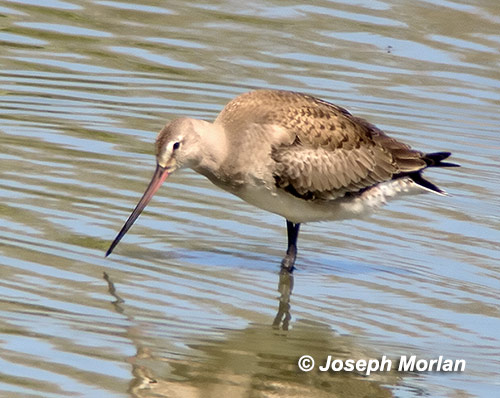
The anchor shaped markings on the mantle indicate juvenal plumage.
Hudsonian Godwit (Limosa haemastica)
Napa-Sonoma Marshes Wildlife Area - Huichica Creek Unit, Napa Co, CA
16 September 2013
Joseph Morlan
Photos © 16 September 2013 by Joseph Morlan. All rights reserved. Click
here for larger images.

The anchor shaped markings on the mantle indicate juvenal plumage.
Robbie Fischer and I decided to check out the Hudsonian Godwit, which had been showing well at a farm pond just east of the parking lot for the Huichica Creek Unit of the Napa-Sonoma Marshes State Wildlife Area. The bird was originally found by Murray Berner on 11 September and had been seen daily. We arrived shortly before noon and met Leslie Flint, Jennifer Rycenga, Peggy Macres, Roy Carlson and others who were just leaving. The bird was at the expected farm pond just north of the railroad tracks at the south end of Buchli Station Rd.. The Hudsonian Godwit was associating with a single Marbled Godwit at the east end of the pond where we spent the next hour studying it. The godwit spent much time foraging in water up to its belly, feeding actively with its head under water. I attempted to digiscope it with the results seen here, but most of my photos show the bird with its head underwater.
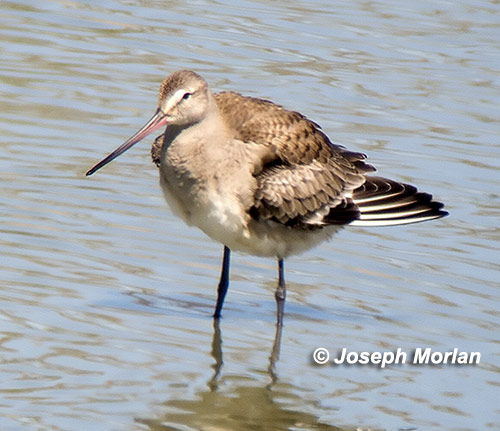
Wing slightly spread showing white outer webs to black primaries and primary coverts.
Description
The following description is based on memory and on photos:
This godwit was only slightly smaller than the nearby Marbled Godwit. It was much duller in color, lacking the warm tones of the Marbled Godwit. Its bill was long and slightly upturned with a dull pink color at the base extending almost half way out. Its face was much more distinctly patterned compared to the Marbled Godwit. It had a capped appearance with bold white supra-loral stripes contrasting with a narrow dark lore stripe between the eye and the bill. The upperparts were gray-brown with its mantle showing distinct dark crescent shaped terminal markings and dark shaft streaks combining to form an anchor-shape. The wing coverts were paler and grayer contrasting slightly with the darker scapulars. The underparts were grayish-buff on its breast, sides and flanks, fading to white on its belly and undertail coverts.
When the bird spread its wings, the pattern of the upperparts showed a bold white wing-stripe, recalling the pattern of a Willet. The underwing had striking black axillars and wing linings, but the undersides of the remiges appeared white, more white than I expected. The marginal coverts were short and presented an odd mixture of white and black feathers, appearing black on the folded wing, but more white when the wing was spread. The wing-tip was long with long primary projection beyond the tertials.
The rump was white. The tail was white at the base with a bold black tail-band broader in the middle and narrower on the outside. Very narrow whitish tips to the tail feathers were evident. The legs were long. and blackish.
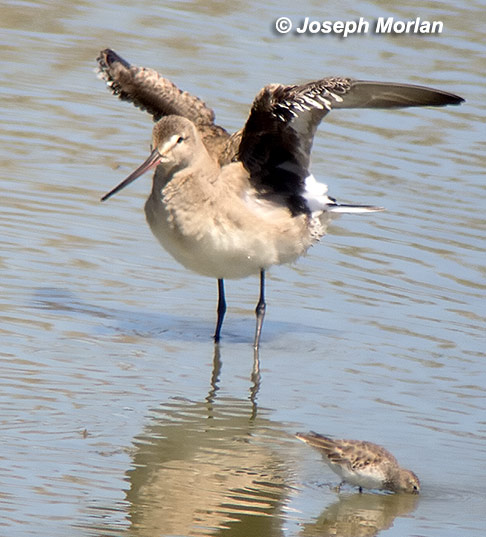
Wings spread showing dark axillars and underwing coverts
Discussion
Status in California
There are forty-six previously accepted records of this species in California, but this appears to be the first for Napa County. Most records are of juveniles in Fall, primarily along the northwest coast. This species is a long distance migrant, wintering mostly in South America, but a few birds winter regularly in New Zealand. It is considered vulnerable with a total population estimated at 50-70k birds in a localized and patchy distribution on both the breeding grounds and wintering areas. Furthermore, the population appears to be decreasing.
Identification
Hudsonian Godwit is similar to the Black-tailed Godwit (Limosa limosa) of the Palearctic, unrecorded in California but a vagrant to Alaska and the East Coast. Black-tailed has a straight bill, not upturned as in Hudsonian. In all plumages, the dark wing-linings of Hudsonian should separate it from the more extensive white wing linings of Black-tailed. Hudsonian is said to have a narrower white wing-stripe, but that difference can be subtle and less reliable than the underwing pattern. In juvenal Plumage, Black-tailed is much warmer in coloration with rich buff head and breast and a different mantle pattern with dark diamond-shaped centers and rich buff fringes.
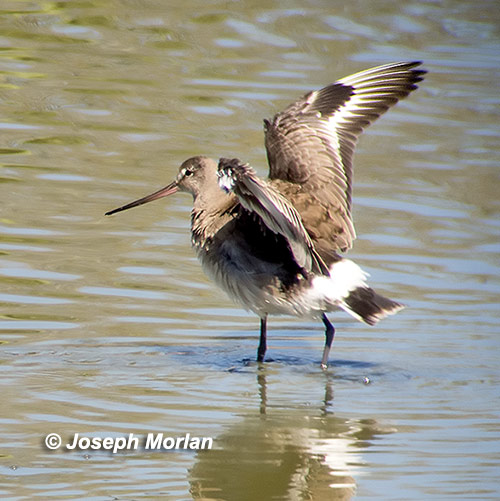
Wings spread showing white wing stripe, white rump and dark tail band.
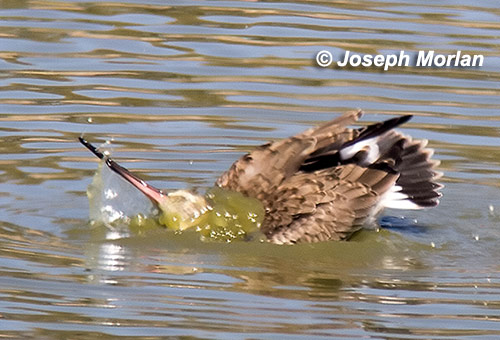
Bathing showing details of the dark tail band.